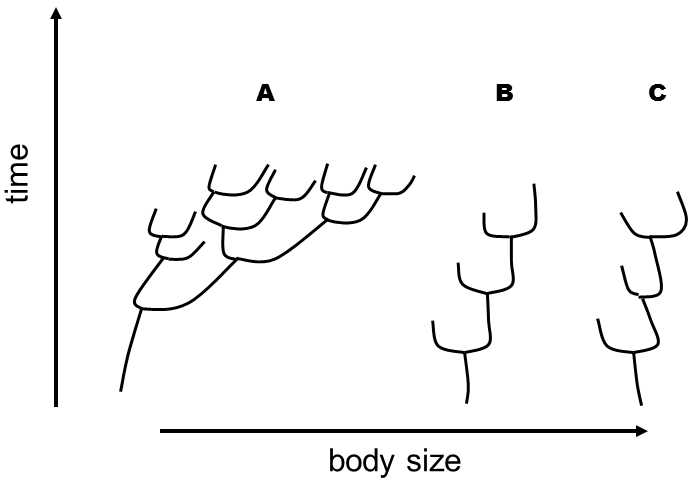XXVI.7.3 An evolutionary trend could be the consequence of species selection
Species selectionis another mechanism that could be responsible for an evolutionary trend.In species selection during evolution, species gradually predominate that have properties leading to higher frequency of speciations and lower frequency of extinctions.If, for example, there is a greater probability that a species with members with greater body dimensions will split off into a new species from two sister species, the species in the given phylogenetic line will gradually get larger {13989}.The reason why species with larger individuals will have a greater tendency to undergo speciation can be identical for all species and could consist, for example, in the fact that this species will have greater dispersion, as a result of which it will more probably form new species through peripatric speciation.Thus, this species can form smaller populations which would facilitate its passage through valleys in the adaptive landscape.The reasons why a particular species is larger than its sister species can, however, be very varied, and can even include chance.
An overall evolutionary trend driven by species selection can move in the opposite direction to intraspecific anagenesis occurring for most of the species in the particular line (Fig. XXVI.9).

Fig. XXVI.9 Evolutionary trends. In principle, there are two different mechanisms of an evolutionary trend. Phylogenetic tree A depicts the situation where the relevant anagenetic change, an increase in body size, occurs during the existence of the individual species, apparently through the action of natural selection. Scheme B depicts the situation where the species do not change during their existence (or can, with the same probability, get larger or smaller). However, the trend is based on species selection, specifically the fact that larger species undergo speciation with greater probability. Scheme C depicts a situation in which natural selection and species selection act in opposite directions, the body dimensions of the individual species mostly decrease in time and larger species undergo speciation with greater probability, so that, as a consequence, the trend towards an increase in the species size predominates.
Then, for example, the action of intraspecific selection can lead to most species getting smaller on an average during their existence; however, if large species have a greater tendency to undergo speciation, the overall evolutionary trend will appear on a macroevolutionary scale as an increase in body dimensions.
